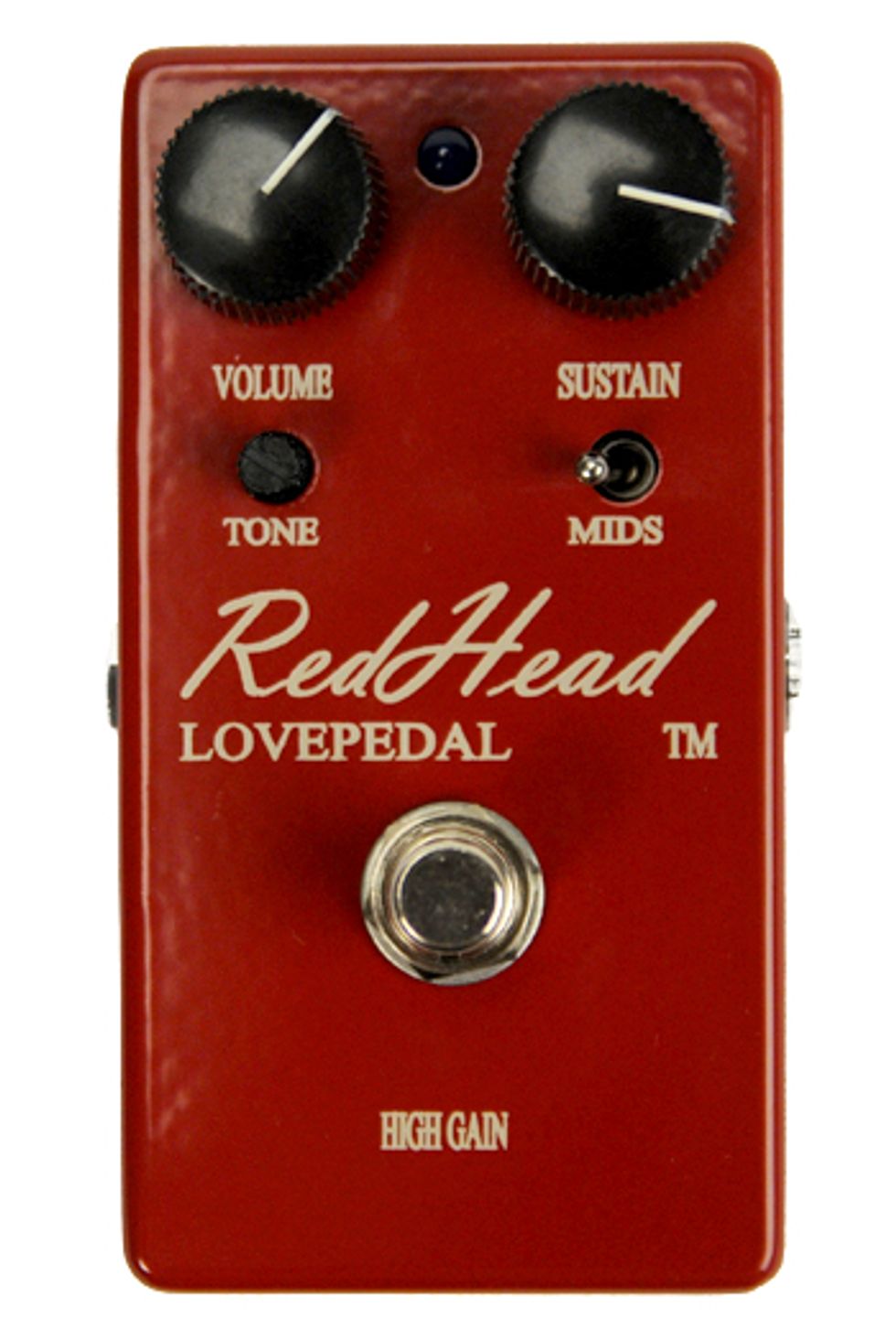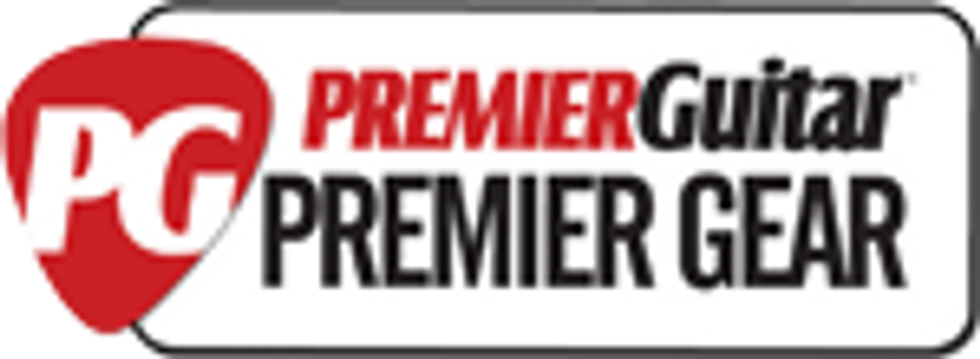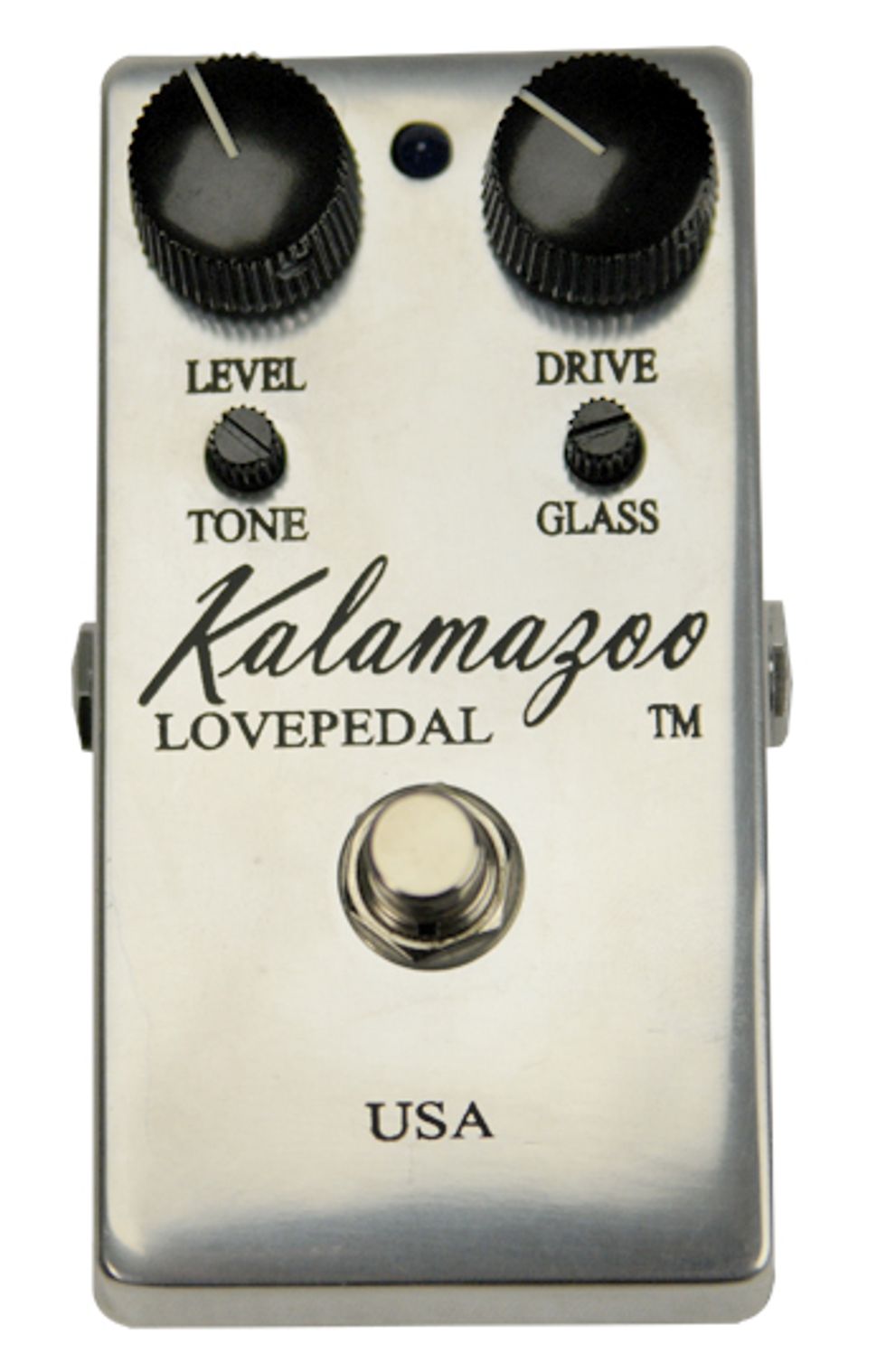A flexible, chimey overdrive and an aggressive, high-gain distortion from Lovepedal are reviewed.
Sean Michael at Lovepedal is clearly a busy man. In this month's print issue, we reviewed four of his new line of ultra-compact pedals, and now we’re back to check out a pair of very different new offerings, the Kalamazoo and RedHead.
Both the Kalamazoo and RedHead are housed in die cast aluminum cases the same basic size and shape of an MXR Phase 90 (4.37” x 2.37” x 1.07”). The battery compartments are accessed via the back panel by removing four machine screws. For those who power their effects with a power supply, there is a 9VDC input located on the left side of the pedal. Each pedal also features true a true bypass stomp switch with accompanying blue LED. The input and output follow tradition with the input jack on the right and the output jack on the left.
I tested both pedals out with a Gibson Les Paul, Fender American Standard Strat and a Hamer Korina Special into a 3rd Power American Dream combo (blackface and brownface-inspired channels) and a 1970 Marshall Superbass through a Mojave 2x12 with Eminence Governor and 70s blackback Celestion G12M.
RedHead
  | |
| Download Example 1 Les Paul, hard rock rhythm tone | |
| Download Example 2 Les Paul, sharp, focused high-gain tone | |
| Download Example 3 Strat, Ritchie Blackmore tone | |
| All clips recorded through a 3rd Power American Dream combo with an SM-7 into a Summit Audio TPA-200B tube mic pre, direct into Pro Tools. | |
In Play
Once again I began with the Les Paul/Marshall combo and set all controls midway and the Mids switch in the left (off) position. This is clearly a different beast than the Kalamazoo, and I mean “beast” in the best way. The tone went from a dirty clean to a volatile monster with a downright irreverent mid sound that Billy Gibbons would be proud of. All the honk, grease, and gain you ever wanted came screaming right out of the gate.
Backing the Volume down and pushing the Sustain up resulted in a screaming, fiery sound with a pronounced pick attack that added an aggressive quality to the already aggressive tone. Pinch harmonics were never so easy to achieve, until I switched on the Mids switch. With the Mids on, there was a good amount of volume boost as well as a boxy tone that had honk and bite at the same time. Boxy isn’t a word usually used to describe a desirable sound but in this case it is—total character.
On the RedHead, the Tone control is the reverse of the Kalamazoo in that it adds bite and presence to the sound. I found myself constantly tweaking it to achieve various sounds from biting and angry to smooth and sustained. Backing the Sustain off to around noon and cranking the Volume resulted in the thickest, most badass attack I’d heard through my Marshall in years, and I loved the sound of the amp acting like it was going to give way at any second. This is not a subtle pedal!
The Strat ended up being my favorite guitar with the RedHead. As a huge Ritchie Blackmore fan, I loved how it easily conjured up Rainbow tones like “All Night Long.” Blackmore’s tone has always been a favorite of mine because it was aggressive yet clear, and when he hit chords hard you could tell the amp was ready to explode. Even in relatively low volume settings on both the Marshall and American Dream, it was easy to recreate that vibe.
The beauty of this pedal once again lies in the interplay between the controls. Much like a master volume tube amp, when you push up the Volume the tone resembles the thickness of power tube distortion and the Sustain acts very much like preamp distortion. With the combination of the two and setting the amp up to clean or slightly dirty there are a huge range of distortion tones available. Add in the ability to dial in extra mids or bite through the Tone and Mids and the possibilities are endless.
The Verdict
If you bought this pedal only for the ability to create aggressive and cool harmonic feedback it would be worth the price of admission. The fact that the RedHead offers up everything from vintage-inspired gain to modern, aggressive distortion made it a winner on every level for me.
Buy if...
you want aggressive yet musical gain with killer mids
Skip if...
you’ve never made a pact with the devil and don’t plan to
Rating...
Street $199 - Lovepedal - lovepedal.com |
Kalamazoo
 | |
| Download Example 1 Strat, slight overdrive with chime | |
| Download Example 2 Strat, Funk with hairy overdrive | |
| Download Example 3 Les Paul, dark sustained drive | |
| All clips recorded through a 3rd Power American Dream combo with an SM-7 into a Summit Audio TPA-200B tube mic pre, direct into Pro Tools. | |
In Play
Admittedly I cheated a bit and checked out the fantastic clips on the Lovepedal site before the Kalamazoo arrived, so plugging in there was a relatively high level of expectation already set. I began with the Les Paul and Marshall dialed in to a slightly dirty clean tone and set the pedal controls midway. Aside from the boost in volume, the first thing that struck me is how the Kalamazoo added its own signature while leaving the Les Paul/Marshall sound distinguishable. This setting was slightly darker than I anticipated, so I dialed back the Tone to fully counterclockwise, which opened up the sound significantly. Hearing how wide the sweep was, I decided to crank the Glass control, which added a good deal of bite without sounding brittle or harsh. This is where the beauty of the Glass control comes in. Most pedals don’t retain bass the same way when you crank up the treble control, and I appreciate the fact that this didn’t erase the “knock” I so love about Marshalls. Bringing the Drive up to higher levels increased sustain and harmonics while slightly compressing the sound more. It made everything denser and more complex, yet I could still hear every note clearly in chords—no small feat. The real treat came when I dimed the Level and pulled the Drive back to around 11:00. This setting became my favorite because it pushed the front end of the amp beautifully to make notes explosive and percussive. Surprisingly, even in the most extreme settings there was a negligible amount of noise added to the overall hum of the Marshall. In fact, it was downright quiet by any pedal standards. Rolling off the guitar’s volume knob didn’t totally clean up the sound, but it didn’t matter because the tone was killer even if there was some residual grit leftover.
Moving on to the Strat/Marshall combination, the Kalamazoo proved that it isn’t a one-trick pony. All the Stratiness came through and the guitar’s chime turned into a buttery and luscious tone that retained the majority of top end while somehow not sounding shrill. My beef with Strats is also their strength, that sparkly top end, but sometimes it can get a bit ice-picky with the wrong amp. Not to worry with this pedal, as any harshness was gone just by stomping it on. One setting that floored me was the Level up to around noon, the Drive down all the way, the Glass cranked. While slightly overdriven, the note definition was incredible and notes sweetly sustained before effortlessly feeding back to a beautiful bloom. Everything just sounded bigger and it gave my playing an instant boost of confidence. Nice!
The Hamer/American Dream combination fared equally as well, barking out big chords with the P-90s and feeling powerful and bold. With just a bit of extra Drive, the P-90s sounded like massive humbuckers while never getting overly grainy or undefined. And oh, the dynamic response…it’s amazing. You can go from a whisper to a roar with just the touch of your hand, which was truly inspiring.
If there was anything I wanted it was probably just a hair more treble response. There were times when I wished the Tone would go to -1 and the Glass went to 11, just for that extra push over the cliff. Then again, my amps weren’t set to be neutral, so it would be possible to dial in more brightness on the amp end of things. Either way, the tone was always stellar and inspiring.
The Verdict
The Kalamazoo is a winner. It imparts its own signature tonal stamp and has enough flexibility to go from slightly overdriven to blooming gain that sings like there’s no tomorrow. Anyone looking for gain and beauty (in tone and looks) in one pedal will very happy with it.
Buy if...
sweet sustain, chime and touch dynamics are what you want
Skip if...
you need more bite and treble in your overdrive
Rating...
Street $199 - Lovepedal - lovepedal.com |
